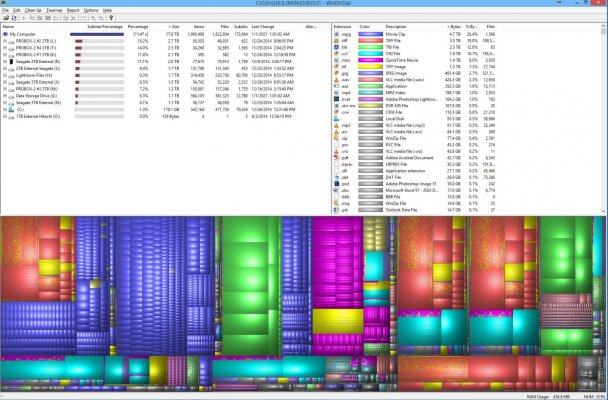RonBoyd
Give me a museum and I'll fill it. (Picasso) Give me a forum ...
How do hard drive makers make any money?
Or is the price finally getting down to a normal profit margin level.
Last edited:
How do hard drive makers make any money?
They can't get these items through normal corporate sourcing.
While you have only a factor of 12 to get to a petabyte drive 10**15 you have 12000 to get to 10**18 exabyte. According to Wikipedia the rate of growth of disk capacity is about 8-12% per year Hard disk drive - Wikipedia, the free encyclopedia. Which implies a doubling every 6 years or so. Forecasts suggest the rate increasing up to 20% per year or perhaps a bit faster implying a doubling of 3 years. So to get to the petabyte drive (assuming no limits by physics) it could be about 10-15 years for the petabyte drive, and about 14 or so doubleings to get to 10**18, or perhaps 50 years or so.I just bought 15 8TB internal hard drives, helium sealed for cooler running for $750 each. That's $100 less than when I bought another 15 about a month and a half ago. Amazing price drops. I'm waiting for the first commercially available XB hard drive.
So your "Black Market" sources are able to deliver them?
While you have only a factor of 12 to get to a petabyte drive 10**15 you have 12000 to get to 10**18 exabyte. According to Wikipedia the rate of growth of disk capacity is about 8-12% per year Hard disk drive - Wikipedia, the free encyclopedia. Which implies a doubling every 6 years or so. Forecasts suggest the rate increasing up to 20% per year or perhaps a bit faster implying a doubling of 3 years. So to get to the petabyte drive (assuming no limits by physics) it could be about 10-15 years for the petabyte drive, and about 14 or so doubleings to get to 10**18, or perhaps 50 years or so.
This kind of precision is unbelievable, yet they sell these drives at such ridiculous retail prices. Very expensive machinery and processes are used, so the lower labor rate in China or Thailand is not the enabling factor.
How the heck can the head positioning seek to a 30-nm wide track? And the bearing precision, the mechanical wobble of the spindle bearings must be commensurate. Astounding! Remember that this is down to the same level as line width of ICs, and the latter do not have moving parts.
By the way, helium is used to fill the new drives because it is light and offers less drag. But this implies that the drive must be hermetically sealed, else you lose helium with time by leaks.
It occurred to me that for the last 15 year, I have enjoyed hard disks that get cheaper and larger in storage capacity, but have not bothered to look further to see how the technology has evolved. ...
This kind of precision is unbelievable, yet they sell these drives at such ridiculous retail prices. ...
How the heck can the head positioning seek to a 30-nm wide track? And the bearing precision, the mechanical wobble of the spindle bearings must be commensurate. Astounding! ...
Interesting - the ones I've taken apart are as you describe, a filter to allow clean air to flow, or just allow pressure to be even in/out.By the way, helium is used to fill the new drives because it is light and offers less drag. But this implies that the drive must be hermetically sealed, else you lose helium with time by leaks. Ten years ago when I last looked at a drive that was opened, I saw that it was vented to the atmosphere via a small breathing hole, which was covered by a dust filter.
I don't know, I definitely recall some drive prices going up on Amazon for awhile around that time period.
But maybe also the popularity of SSDs is driving HDD prices down too.
I don't know, I definitely recall some drive prices going up on Amazon for awhile around that time period.
But maybe also the popularity of SSDs is driving HDD prices down too.
I agree, it is amazing that this precision can be delivered at such affordable prices. It really makes me wonder why some other products are so expensive?
But some of this 'precision' is accomplished with feedback, I imagine? I don't think the bearings need to be so very precise, the head could follow a slight wobble. A 7200 RPM disc is only 120 revs per second, so the corrections would just take a 120 Hz pattern (sinusoidal if the bearing is just off-center, could be other harmonics, or 'noise' if there are other bearing imperfections?).
-ERD50
While you have only a factor of 12 to get to a petabyte drive 10**15 you have 12000 to get to 10**18 exabyte. According to Wikipedia the rate of growth of disk capacity is about 8-12% per year Hard disk drive - Wikipedia, the free encyclopedia. Which implies a doubling every 6 years or so. Forecasts suggest the rate increasing up to 20% per year or perhaps a bit faster implying a doubling of 3 years. So to get to the petabyte drive (assuming no limits by physics) it could be about 10-15 years for the petabyte drive, and about 14 or so doubleings to get to 10**18, or perhaps 50 years or so.
I just bought 15 8TB internal hard drives, helium sealed for cooler running for $750 each.

I ran the built-in find file on Win7.
On a new Dell, I found two 2.6GB installers for Photoshop elements and premiere.
On arrival the disk had 35GB on it. This means Dell had 10% waste built-in. LOL.
